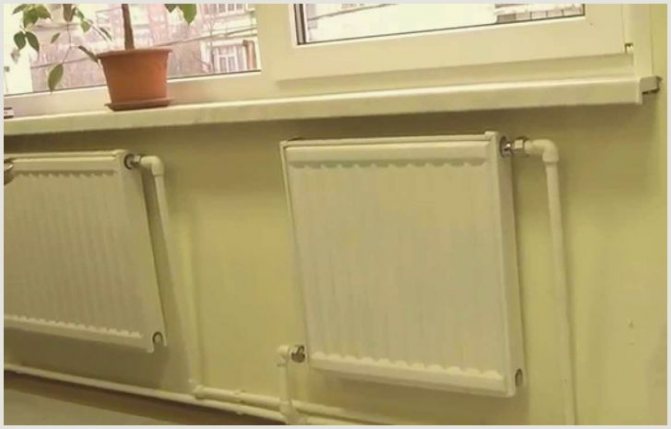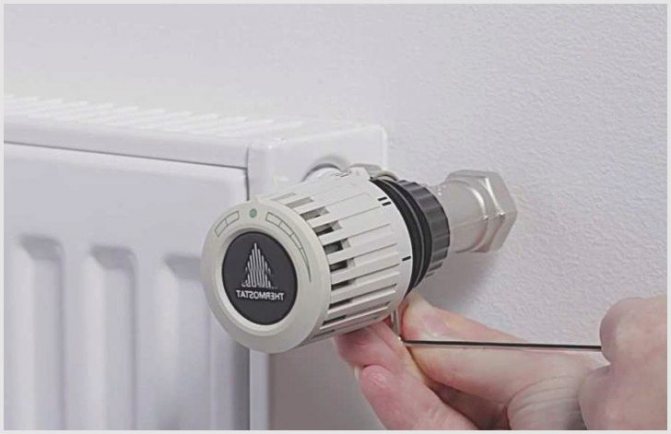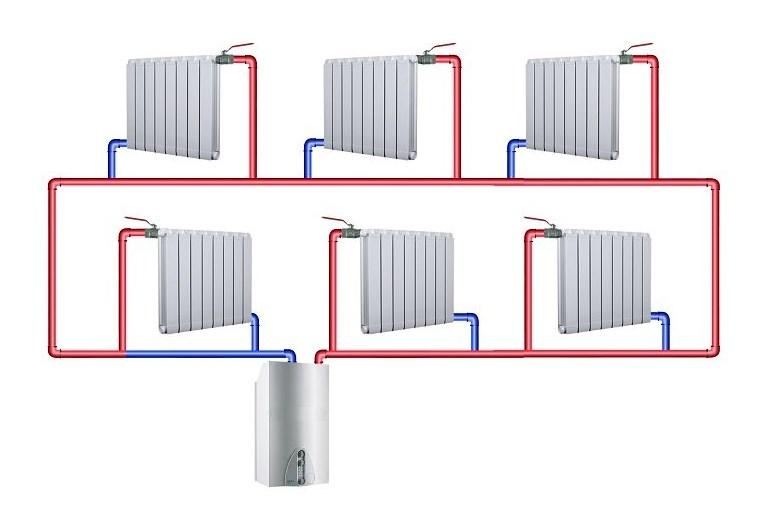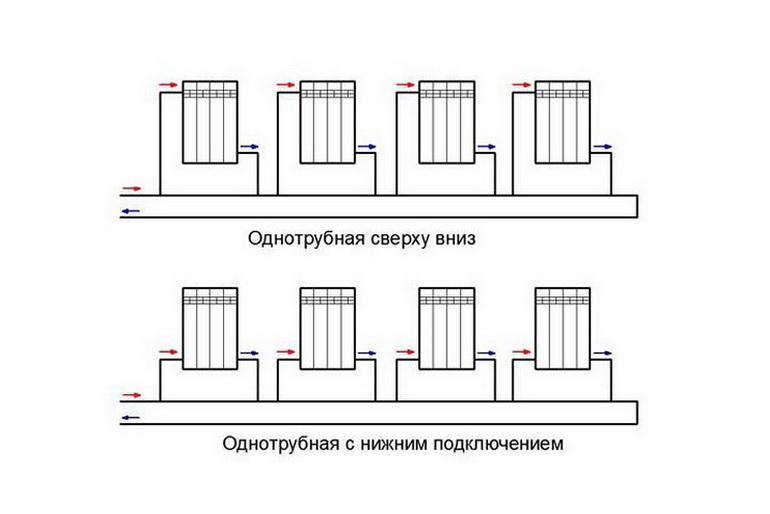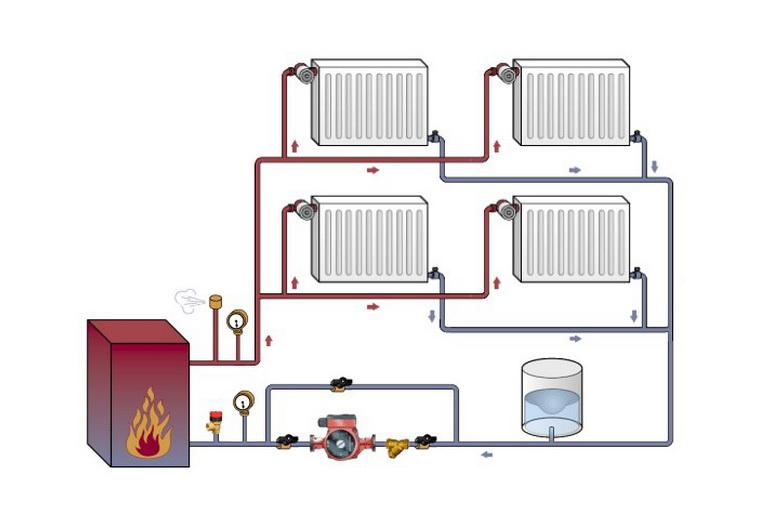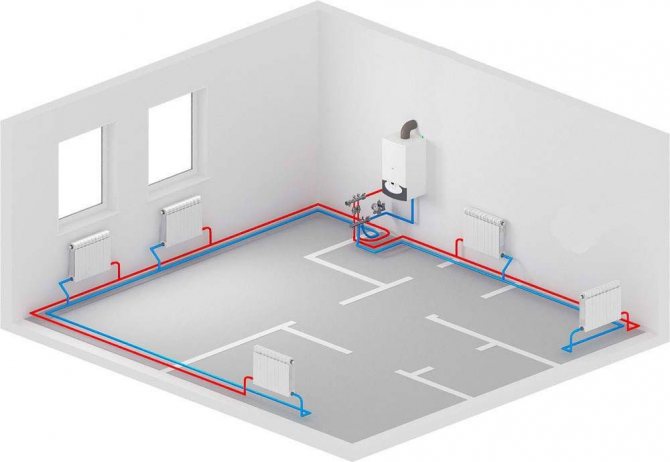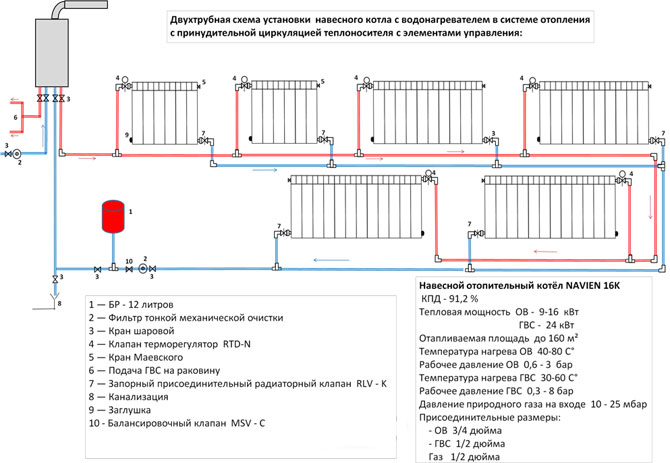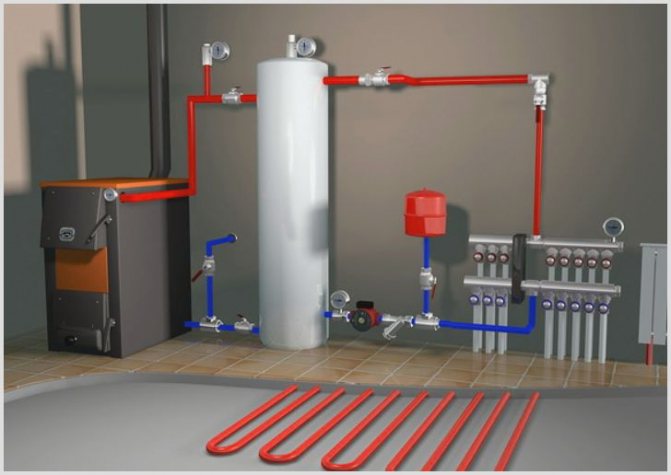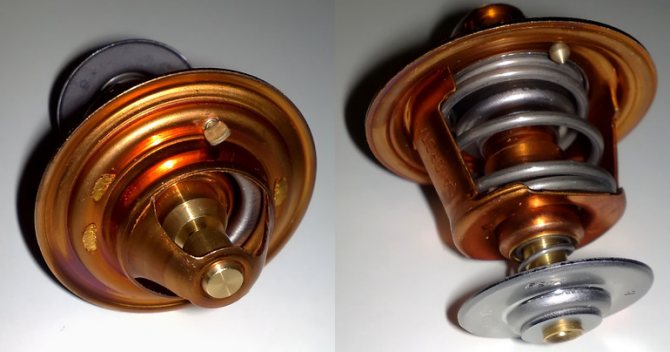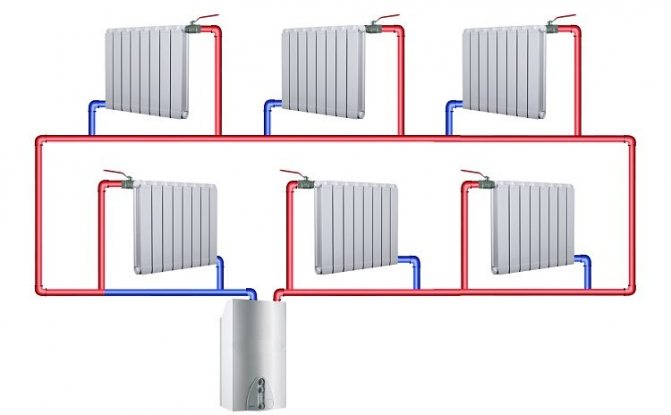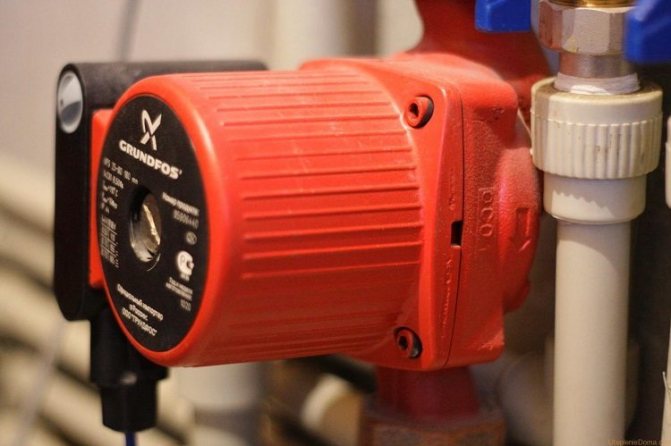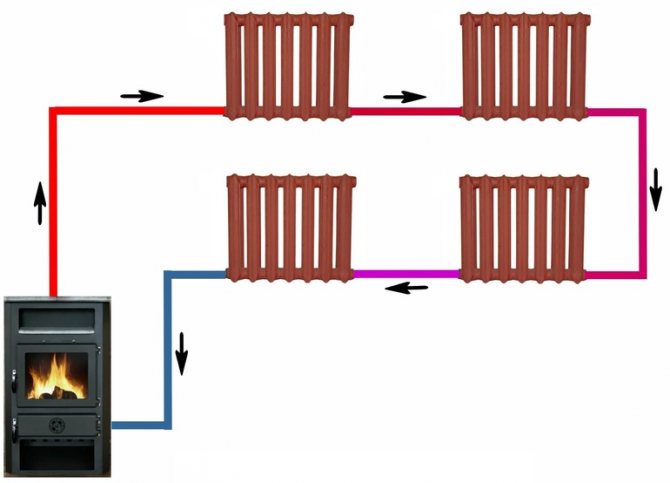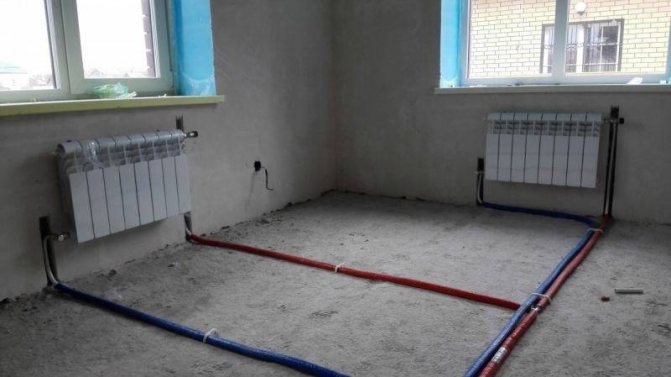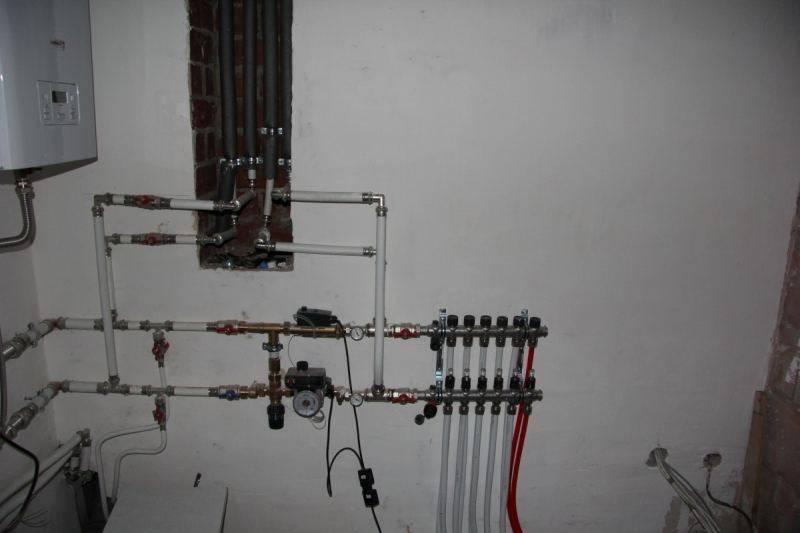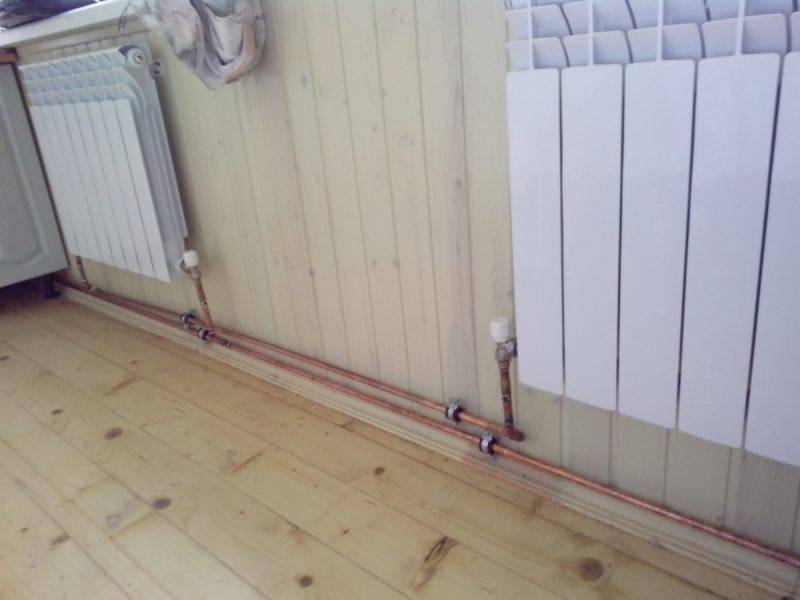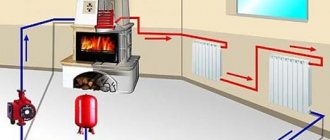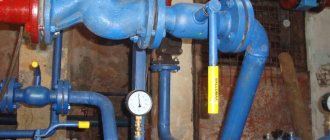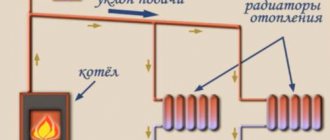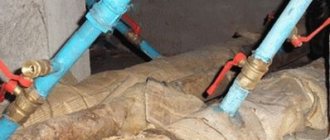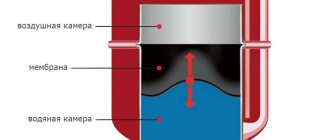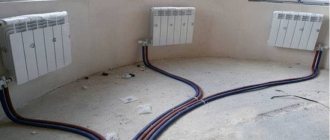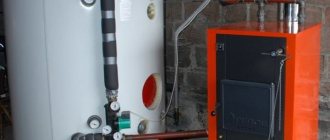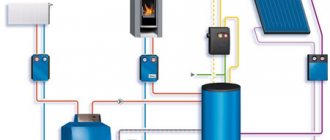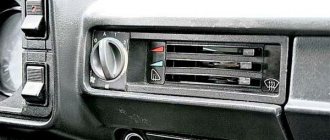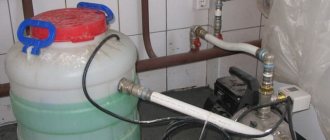Two-pipe heating system
The principle of operation of a two-pipe heating system is somewhat different from that described above. In this case, the coolant rises along the riser and is supplied to each heating battery. And then, along the return line, it returns back to the pipeline, which transports it to the heating boiler.
With this scheme, the radiator is served by two pipes - supply and return, therefore the system is called two-pipe.
What are the benefits of this layout?
Two-pipe line
What can you expect by choosing this option for organizing heating of a private and residential apartment building?
- Such a system allows for uniform heating of each radiator. Any battery, no matter what floor it is on, receives hot water at the same temperature. If desired, a thermostat can be installed on the radiator, and then the weather in the house lends itself to self-regulation. The heat transfer of radiators installed in other apartments is not affected by the use of a thermostat in a single room.
- In a two-pipe piping, there are no large pressure losses during the circulation of the coolant. Therefore, a powerful hydraulic pump is not needed for the normal functioning of the system. Water is able to circulate due to gravitational force, that is, by gravity. And if the water pressure is weak, it is enough to install a low-power pumping unit, which is more economical and easy to maintain.
- With the help of shut-off equipment, bypasses and valves, it is easy to organize such schemes that will allow you to repair one heating device, if necessary, without turning off all the heating of the house.
- Another additional bonus of two-pipe piping is the ability to use associated and dead-end hot water.
What is a passing scheme? This is when water flows both in the supply and in the return in the same direction. In a dead-end scheme, the supply and return water circulates in opposite directions. When driving along the way, provided that radiators of the same power are used, an ideal hydraulic balance is established. Therefore, it is not necessary to additionally use battery presetting valves.
If the heating devices have different power, you will have to calculate the heat loss of each, calculate and link the radiators using thermostatic valves. It is very difficult to do it yourself without knowledge and skills.
Note! Associated hydraulic gravity is used where long-distance pipelines are installed. For short systems, a dead-end scheme for the movement of the coolant is used
Classification of a two-pipe heating system
Types of systems
The classification of the two-pipe piping is made according to the location of the pipeline and the method of arranging the piping system.
According to the location of the pipeline, it is divided into vertical and horizontal. In a vertical arrangement, all batteries are connected to a vertical riser. This option is most often used in apartment buildings. The main advantage of this connection is the absence of air congestion.
For a large private house, experts recommend choosing a horizontal two-pipe wiring and installing a Mayevsky crane in each radiator. It is needed to bleed air, and an example of its correct installation has been described in detail in previous articles more than once.
According to the wiring method, the two-pipe system can be with lower and upper piping. In this case, the hot water riser is placed in the basement or basement. The return line is located here, but is installed below the supply. All radiators are at the top. An upper air line is connected to the common circuit, which allows excess air to be removed from the system.
When installing the upper trim, the entire distribution line is mounted in the insulated attic of the building. An expansion tank is also installed there. You cannot use this scheme if you have a flat roof.
Disadvantages of a two-pipe system
Dual-circuit system
Comparing the two battery harness circuits, it is easy to conclude which one is better. The two-pipe system is much more efficient in any case. But it has one significant drawback. It will take twice as many pipes to assemble it. In addition, they come with a large number of fasteners, valves and fittings, so the installation of a two-pipe system is much more expensive.
Until recently, when steel pipes and labor-intensive welding processes were used to assemble a two-pipe piping, the amount was prohibitive. With the advent of metal-plastic and hot-brazing technology, the laying of a two-pipe line has become available to almost everyone.
Double-circuit heating circuit
A standard two-pipe heating system works on the principle of circulation of the coolant circulating from the boiler to the radiators and vice versa, and one pipe is used to move forward, and the second pipe is used to move back to the boiler.
Unlike a single-circuit scheme for a private house, a two-pipe heating system can be closed or open. This means that the expansion tank can be diaphragm (closed) or conventional, with an open, leaky top. In a closed circuit, no air enters the system. According to the node connection scheme, the two-pipe scheme is no different from the one-pipe one: vertical and horizontal connection of devices is realized.
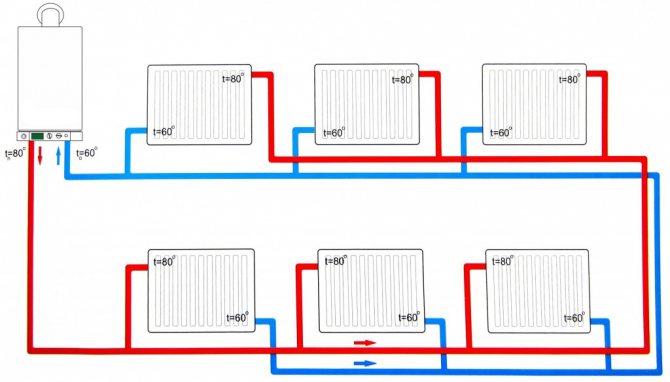
When installing a vertical riser, each floor can be connected to one pipe separately, and the number of radiators in each apartment is not limited, and there can be no air locks by definition. The advantages and disadvantages of such a scheme will be discussed below.
Horizontal two-pipe connection of radiators is mainly used in low-rise buildings with a large heated area. The main distribution pipe lies horizontally on the floor, and radiators are connected to it. The coolant return pipe runs next to the supply and all radiators of the system are also connected to it. With this connection, the air is vented by Mayevsky's taps, since such a scheme is based on the heating principle of the one-pipe system.
A horizontal one-pipe heating circuit can be assembled with an upper or lower pipe distribution. Bottom connection of radiators means that the supply pipe is laid at the bottom of the room - on the floor, under the floor or in the basement. The return flow in this version goes under the supply pipe, and the boiler goes deep below the level of all radiators. The circuit also includes an air pipe through which air is removed from the pipes.
If the two-pipe wiring is top, then the working fluid is supplied through the attic.
The indisputable advantages of providing heat are the advantages of a two-pipe heating system:
- Automatic temperature controllers are included in two-pipe heating, which makes it possible to regulate the heat transfer on each radiator;
- Pipe connections differ from a single-circuit diagram by the presence of a collector, which ensures the independent operation of each circuit;
- Also, this scheme will differ from a one-pipe parallel connection of all elements of the heating network;
- The scheme is completely autonomous, and it does not need to be stopped to connect additional circuits or heating devices;
- Another advantage of such a scheme: the main pipes can be shortened without turning off the heating, or vice versa - extended in any direction;
- To increase heat transfer, it is not necessary to increase the volumes of the working fluid or sections in the batteries - it is enough to increase the flow rate of the coolant and the combustion of fuel in the boiler;
- The system is easily repaired and altered, so which scheme to choose, which scheme is better, is clearly not necessary if you are the owner of a low-rise private house.
Disadvantages of a two-pipe heating system:
- The piping layout and connection of devices are much more complicated;
- The high cost of materials and work;
- Complex installation and start-up of the system.
How to assemble a heating system with horizontal top piping:
- A fitting-angle 900 is connected to the outlet of the boiler for turning and directing the pipe up;
- The upper line is divorced - for this, corner fittings and tees are used, which are located above the radiators;
- After assembling the upper pipeline, the tees are connected to the upper outlet of the radiators with a tie-in into the pipe of the shut-off valve;
- Around the perimeter of the whole house, a lower pipeline is laid, to which all radiators of the heating system are connected. This highway should be located at the height of the basement of the building;
- The end of the working fluid return pipe is connected to the boiler return pipe, and a circulation pump is cut in here.
A closed system with a constant pressure from the pump and an open system with a leaky expansion tank installed at the highest point of the pipeline are assembled in the same way. When installing a two-pipe system with an open tank, the inconvenience is that it will have to be installed in an unheated attic, which means that it will have to be additionally insulated.
In addition to this inconvenience, hot water cannot be taken from the upper piping for household or technical use, and the expansion tank and the supply capacity of the water supply system of a country house cannot be combined.
How to assemble a heating system with horizontal bottom piping:
The system with bottom piping can only work with a circulation pump, but it allows you to install an open expansion tank in a heated room anywhere. In addition, it is possible to combine the expansion tank and the supply tank of the DHW system, which makes it possible not to control the level of the working fluid in the tank, but to consume heated water directly from the heating system of the house.
Heating system options
The main criterion for separating all heating devices is the type of fuel. In addition, there are universal boilers operating on several types of fuel, which saves on electricity consumption. We suggest that you familiarize yourself with the existing connection diagrams for various heating equipment.
- One-pipe. It is a simple option for laying a line for a coolant in a private and multi-storey building, as well as in an industrial enterprise. It is used in cases where it is necessary to lay a pipeline quickly and with minimal financial investment. The only caveat is the limitation of the length of the pipeline around the house to 30 m. There are three types of one-pipe connection scheme: horizontal, vertical and "Leningradka". They differ from each other in the way of supplying and removing the coolant to the batteries.
- Two-pipe. The batteries are connected to the supply line and return. This distributes heat more evenly throughout the building. Water is supplied to each heat exchanger at approximately the same temperature.A similar scheme is mainly used in multi-storey buildings with a large number of heated rooms. There are options for bottom and top connection.
- Radiation. From two collectors common for the floor, two pipes fit each of the radiators. The collectors themselves are connected to the common boiler equipment. With this scheme, you can connect not only batteries to heating, but also a "warm floor". The laying of the ray system must be performed even at the stage of building a house, since it will be extremely difficult to introduce it into an already finished building.


Which heating system is better
Which is better: one-pipe or two-pipe heating system, each user decides for himself. The choice depends on the type of housing and financial capabilities.
In addition, there is heating with natural and forced circulation. In the first case, water flows along the circuit under natural forces, in the second, thanks to the operation of the circulation pump.
Two-pipe heating system
The main design difference of this scheme is two circuits through which the coolant circulates. The first is designed to supply hot liquid to the radiators, the second is to return the cooled coolant to the boiler. In this case, a vicious circle is also obtained. It is a pair of interconnected contours that is the most "repulsive" moment for many owners of private houses. The long length of the main lines, the difficult wiring are the reasons for the dislike for the two-pipe structures.
Two-pipe heating systems can also be open or closed. The difference between them is the presence of different designs of the expansion tank. Closed structures are more practical and convenient to use. In them, membrane tanks are used in the role of a tank, their difference is complete safety. They allow you to add to the circuit (or turn off) heating devices or whole branches, greatly simplify the adjustment of the system.
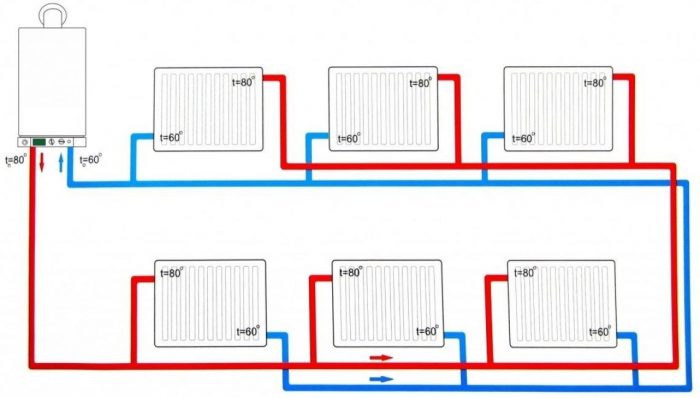

There are two main types of connection of two-pipe structure elements - vertical and horizontal. In the first case, the pipes are connected to a vertical riser for each floor separately. This option is convenient, almost ideal for two- or three-story houses or cottages. In this case, the owners are not afraid of air jams.
Horizontal wiring, which has an upper (in the attic, under the ceiling) or lower (in the basement, under the floor), is usually used for one-story buildings with a large footage. Or for large buildings with several floors, if floor level adjustment is required. Air locks are eliminated with the help of Mayevsky taps, they are installed on radiators.
Now there is another type of system - radiant heating. In this case, the hot liquid is distributed through the manifold. Adjustment is possible: both the speed of movement and the temperature of the coolant.
pros
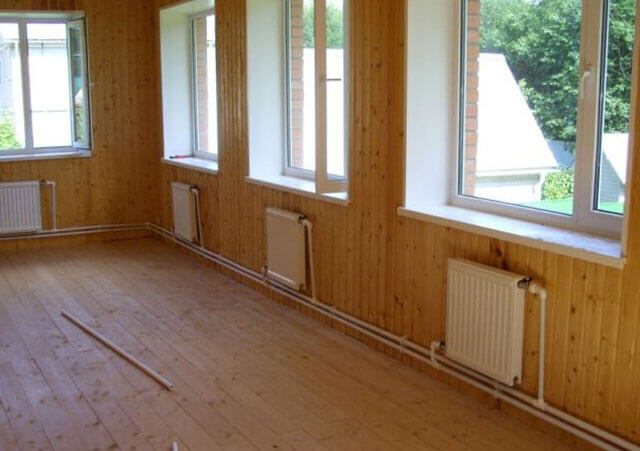

Which heating system is better: one-pipe or two-pipe? If we bear in mind the quality of heating, then the second option has a great advantage: it is uniform heating of all radiators, regardless of their distance from the boiler. Other pluses include:
- thermoregulation, which can be foreseen at the design stage of the heating system;
- parallel connection of elements, which makes it possible to relatively easily replace each of them;
- the ability to add new radiators if you want to increase the heating efficiency;
- a chance to extend the heating structure in any direction: both horizontal and vertical;
- easy elimination of any technical errors directly during installation;
- simple repair work, easy maintenance of radiators.
Minuses
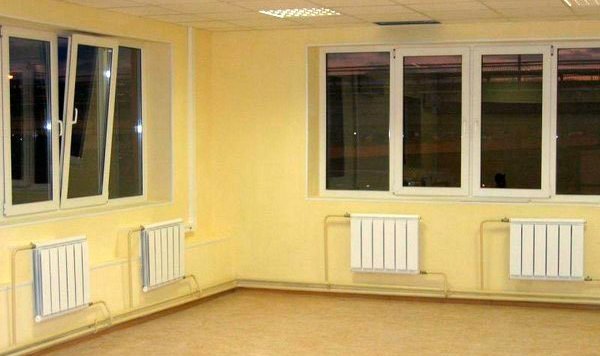

The biggest disadvantage of this system is the higher cost of work. But there are other reasons to think about the feasibility of its implementation. These include:
- a large number of communications, they will have to be hidden, which means that new costs are inevitable, because of this, difficulties in service may arise;
- the need for forced circulation by an electric pump;
- exactingness to the author when drawing up a rather complex project;
- installation, which takes much more time, consuming a lot of effort;
- the need to purchase a large number of pipes for wiring, taps that regulate the supply of coolant to each radiator.
If we compare the advantages and the materiality of the disadvantages, then the preponderance will be on the side of the former, however, the complexity of the project, the scale of the work frightens off many. Usually, this option is chosen by those for whom the main requirement for heating is its quality in the cold season.
For a one-story house
The simplest one-pipe heating scheme, which has been used by developers for more than half a century, is Leningradka.
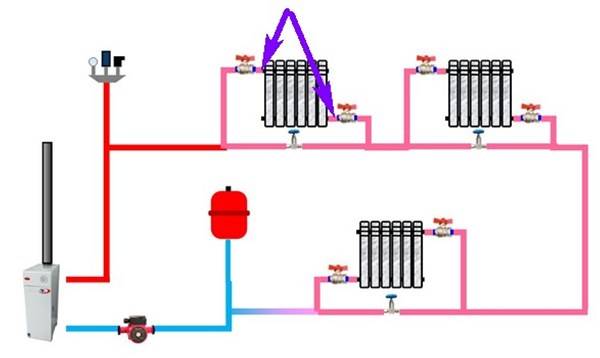

The figure shows a sketch of the modernized version of "Leningradka", with diagonal connection of radiators. The following elements are indicated in the figure (from left to right):
- Heating installation. For the implementation of this CO, boilers operating on solid fuels, gas (natural or liquefied) and electricity are suitable. Theoretically, liquid fuel boilers are also suitable, but the problem of storing fuel in a private house arises.
- The safety group, which consists of a blasting valve adjusted to a certain pressure in the system, an automatic air vent and a pressure gauge.
- Radiators connected to the system through shut-off ball valves. Needle balancing valves are installed in the bridge between the inlet and outlet of each radiator.
- A membrane expansion tank is installed on the return branch of the pipeline to compensate for the thermal expansion of the coolant.
- A circulation pump that creates a forced movement of the coolant through CO.
Now about what is not yet indicated in this sketch, but is a mandatory element for the reliable operation of this scheme. Above, only the pump was mentioned, but its piping was not indicated, which includes three ball stop valves, between which a coarse filter and a pump are installed. Quite often, a pumping group with a piping is connected to the CO through a jumper, thereby forming a bypass.
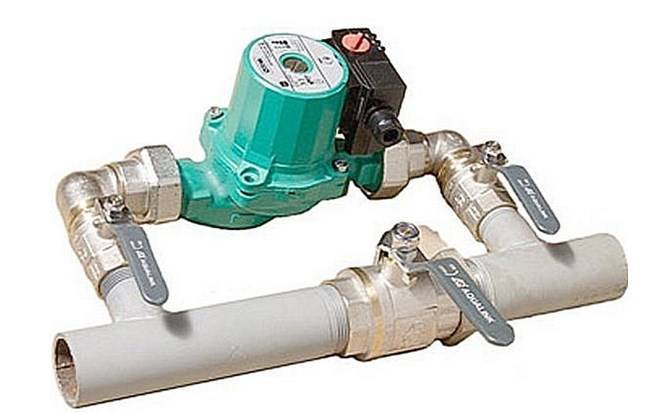

Often, developers ask if a bypass is needed in a one-pipe heating system? The thing is that this CO scheme is self-sufficient and efficient. But in the event of a power outage, the circulation pump will stop and the coolant will stop moving. The bypass is optional, but it is better to build it to switch from forced to natural circulation of the coolant in the event of an emergency.
As for the pipeline: since the temperature at the boiler outlet can reach 80 ° C, it is recommended to use reinforced polypropylene pipes of the required diameter for the Leningradka circuit. Why reinforced? The thing is that polymer pipes are quite cheap and practical, they are easy to install and they have a small mass. But, polymer pipes change their length when heated. Reinforced polymer does not suffer from such a "disease".
Advice: despite the fact that this CO option provides an automatic air vent, there are cases of airing the circuit. To solve this problem, it is recommended to use Mayevsky cranes on radiators.
Distinctive features of the heating system
The biggest plus is electrical independence, and the minus is pipes, which have a large diameter and the wiring is made at a slope.
In comparison with the two-pipe version, there are quite a few advantages:
- pipes can be diverted to the "warm floor" system or heating radiators can be connected;
- it can be carried out regardless of the layout of the room;
- it covers the entire perimeter with a closed ring;
- it is less material intensive and has a lower cost.
When using, difficulties may sometimes arise with circulation through the pipes, but this is easily solved by installing pump equipment. It produces competent circulation of the coolant through the pipes.
The vertical one-pipe scheme is a popular example of wiring in apartment buildings.
One-pipe heating system with pump.
And horizontal is used mainly for heating huge rooms and in private buildings are used very rarely (mainly in small one-story houses). Here, the supply pipe bypasses the heating devices, which are on the same level. The water in each radiator cools down and, approaching the last heating devices, it becomes already significantly cooled. This scheme will help reduce installation and piping costs, but has two disadvantages.
Firstly, it is a problem with heat regulation in any heating device. You cannot increase heat transfer, reduce it, turn off the radiator. In the practice of installation, there is a jumper - bypass, which allows you to turn off the radiator without turning off the system. Heating of the room is carried out indirectly by means of a riser or supply pipes. Another disadvantage is that you need to use radiators of various sizes. In order for the heat transfer to be the same, the first heater must be very small, and the last one must be large. A horizontal one-pipe heating scheme is also used.
Pros and cons of a one-pipe system
To begin with, we recall that a one-pipe scheme is a single horizontal collector or a vertical riser common to several radiators connected to it with both connections. The coolant, circulating through the main pipe, partially flows into the batteries, gives off heat and returns back to the same collector. A mixture of chilled and hot water with a temperature reduced by several degrees comes to the next radiator. And so on until the very last radiator.
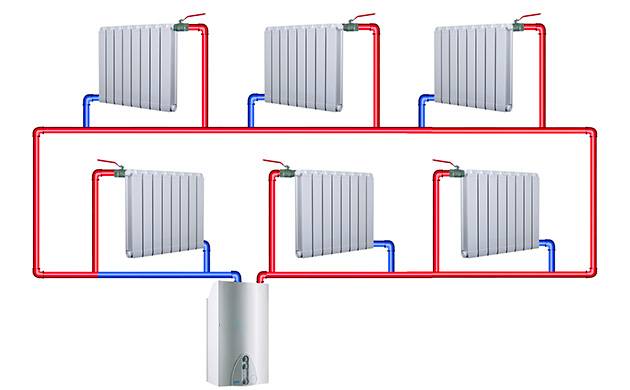

The main difference between a one-pipe heating system and a two-pipe heating system, which gives it some advantage, is the lack of separation into supply and return pipelines. One line instead of two means less pipes and work on their laying (punching walls and ceilings, fastening). In theory, the total cost should also be lower, but this is not always the case. Below we will explain why.
Thanks to the advent of modern fittings, it became possible to regulate the heat transfer of each radiator in automatic mode. True, this requires special thermostats with increased flow area. But even they will not rid the system of its main drawback - the cooling of the coolant from the battery to the battery. As a result, the heat transfer of each subsequent device is reduced and it is necessary to increase its power by increasing the sections. And this is an increase in value.
If the line and supply to the device are of the same diameter, then the flow will be divided approximately equally. This cannot be allowed, the coolant will cool down strongly in the very first radiator. In order for a third of the flow to enter it, the size of the common collector must be made twice as large, and along the entire perimeter. Imagine if this is a two-storey house with an area of 100 m2 or more, where a DN25 or DN32 pipe is laid in a circle. This is the second increase in value.
If in a one-story private house it is necessary to ensure the natural circulation of water, then here a one-pipe heating system differs from a two-pipe one by the presence of a vertical booster header with a height of at least 2 m, installed immediately after the boiler. An exception is pumping systems with a wall-mounted boiler suspended at the required height. This is the third increase in value.
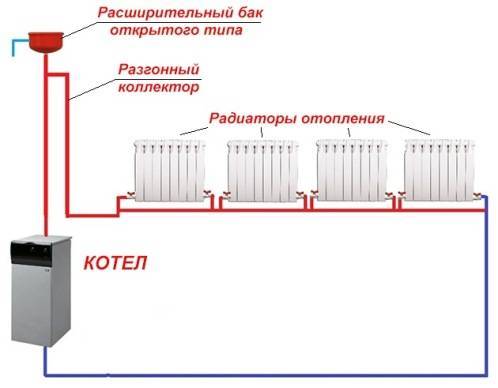

How to remake a one-pipe in two?
The two-pipe system is significantly more efficient in many respects.The use of plastic links and fittings makes the construction process simple and inexpensive. Alteration will not be difficult, but it will require sacrificing the repairs carried out, since you will have to install and gradually build up a return riser and connect batteries to it.
Another option is to install bypasses for consumers close to the boiler in order to reduce their temperature and increase the flow of coolants to the final radiators.
If you have any experience in this field, please share it. You will render a valuable service to craftsmen who have not yet made a choice in favor of one or another option for heating their homes.
One-pipe heating system
This option is used in cases where it is necessary to carry out communications quickly and with minimal costs.
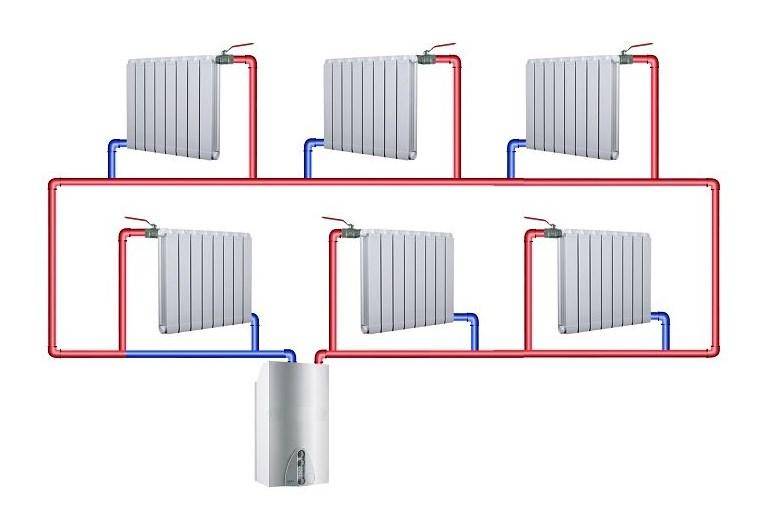

It is used in residential, private and industrial construction. A feature of this solution is the absence of a water return line. The batteries are connected in series, the assembly is carried out in a short time and does not require complex preliminary calculations.
How does a one-pipe line work
In such structures, the coolant is supplied to the upper point and flows downward, successively passing through the heating elements. When arranging a multi-storey building, it is practiced to install an intermediate pump, which creates the necessary pressure in the supply pipe to push hot water in a closed loop.
Vertical and horizontal schemes
The construction of a one-pipe line is carried out in a vertical and horizontal orientation. Vertical distribution is installed in buildings with two or more floors. The coolant is supplied to the radiators, starting from the topmost one. The horizontal heating main is most often used for the arrangement of single-level buildings - houses, summer cottages, warehouses, offices and other commercial facilities.
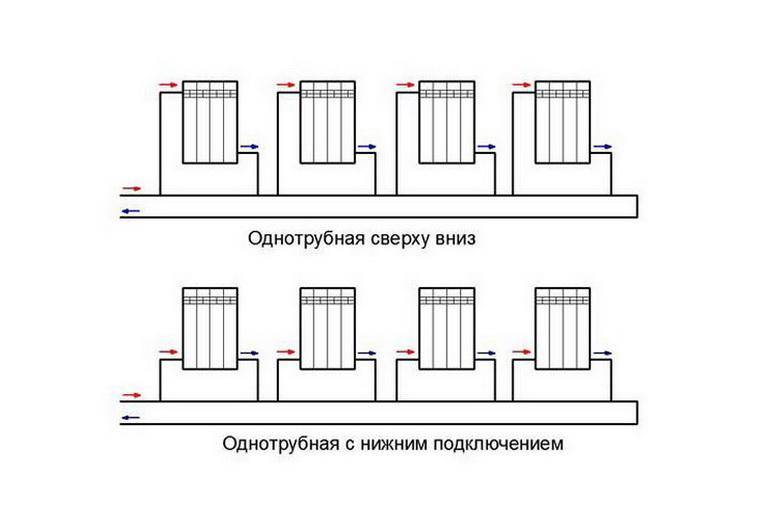

The layout of the pipeline assumes a horizontal arrangement of the riser with its sequential supply to the batteries.
Pros and cons
The single-pipe design of the heating main has the following advantages:
Installation is carried out quickly, which is important with modern requirements for the pace of construction. In addition, the appearance of a one-pipe collector with a height of several meters is superior to a complex system of two lines. Small budget. The cost estimate shows that the construction requires a minimum number of pipes, fittings and fittings. If consumers are installed on a bypass, then it becomes possible to regulate the heat balance separately in each room. The use of modern locking devices makes it possible to modernize and improve the line
This allows replacing radiators, inserting devices, and other improvements without a long shutdown of the system and draining water from it.
This design also has its drawbacks:
- The sequential arrangement of the batteries does not exclude the possibility of adjusting the heating temperature in them separately. This entails cooling all other radiators.
- Limited number of batteries on one line. It is impractical to put more than 10 of them, since at the lower levels the temperature will be below the permissible level.
- The need to install a pump. This event requires additional cash investments. The power plant can cause water hammer and damage to the lines.
- In a private house, you will need to install an expansion tank with a valve to bleed air. And this requires a place and carrying out insulation measures.
The main criteria for choosing a heating system
It is only possible to choose efficient heating wisely if you have knowledge of heating technology. If the arrangement of the system is carried out in a small one-story house, then you can carry out the necessary calculations yourself.If this is a cottage with two or more floors, then it is better to provide the choice of the system to professionals.
The main criterion in choosing heating equipment is the area of the building. An open circuit with a single-circuit piping option is good for small buildings of no more than three stories. The only "but" is the inconvenience of introducing an expansion tank into the system and carrying out repairs in case of any malfunction.
In high-rise buildings, the advantages are on the side of closed-type two-circuit systems. They warm up all radiators evenly. In addition, it is possible to control the temperature of the coolant in any of the connected circuits.
What you need to consider when arranging any system
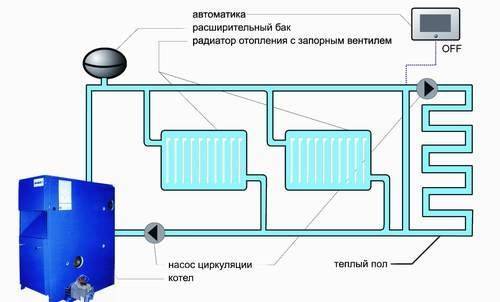

Heating boiler operation diagram.
It is important not to forget to install regulating thermococks at the inlet and outlet of the radiator, as well as a drain valve, which is usually located at the lowest point of the heating structure. The purchase of second-hand pipes and fittings or "cheaply" in any heating system in the future can result in very serious problems that require major repairs not only of the entire heating structure, but also of the house itself due to a possible rupture of pipes with hot water and its flooding
The purchase of second-hand pipes and fittings or "cheaply" in any heating system in the future can result in very serious problems that require major repairs not only of the entire heating structure, but also of the house itself due to a possible rupture of pipes with hot water and its flooding.
Two-pipe heating distribution is possible for a private house with any number of floors. And its work can take place without using a circulation pump. But these systems have a rather low efficiency and in our time are already used by few people.
https://youtube.com/watch?v=IVHMLLJRL6M
When deciding to place a two-pipe wiring in a house with a collector equipment, you need to carefully consider and plan the placement of the coolant distribution unit, the so-called comb. It will be correct to make the length of the pipes extending from it commensurate, since a significant difference in length from the comb to the radiators can lead to a significant difference in pressure. And this will complicate the adjustment of the system as a whole. The best solution in placing the comb is such that there will be approximately equal distance to each of the radiators from it.
Pipes for heating equipment can be copper, steel, polypropylene and metal-plastic, but in no case should you use galvanized pipes. The required type of pipes is selected depending on the construction project and with the preferred characteristics: economic, environmental. But the priority should be the hydraulic performance.
The flow rate of pipes required for laying this system will depend on the selected heating distribution scheme (two-pipe or one-pipe). Private houses with a large area require the equipment of a two-pipe system, into which a circulation pump is additionally cut in. Temperature control in each room is carried out using thermostats.
Double pipe system
There are several types of it. The principle of operation is the same and consists in the following. Hot water rises through the riser and from it enters the radiators. And of them, through the highways and return connections, it enters the pipeline, then into the heating device. With this system, the radiator is served by two pipes at the same time: return and supply, therefore it is called two-pipe. Water is supplied to this system directly from the water supply. She needs an expansion tank, which is either simple or with water circulation.
Diagram of a two-pipe heating system with a circulation pump.
The simple structure includes a container with 2 pipes.One is a water supply riser, and the second is used to drain excess liquid.
A more complex design has 4 pipes. 2 pipes provide circulation, and 2 others are needed for control and overflow, they also monitor the water level in the tank.
Two-pipe systems can be operated using a circulation pump. Depending on the way of circulation, it can be with a passing flow or a dead-end one. In the second, the movement of warm water is completely opposite to the direction of the already cooled one. Such a scheme is characterized by the length of the circulation rings, which depends on the distance of the heater from the boiler. Circulation rings have the same length in systems with one-way water movement, all devices and risers work in equal conditions.
A two-pipe heating system has a large set of advantages compared to a one-pipe heating system:
- the ability to distribute the heat supply in different rooms;
- can be used on one floor;
- locking systems of the return and supply risers are located in the basement - this significantly saves the area of living quarters;
- minimizing heat loss.
The only drawback is the considerable consumption of materials: pipes need 2 times more than for a single-pipe connection. Also, the disadvantage is the low water pressure in the supply line: valves will be needed to bleed air.
The horizontal closed two-pipe scheme is available with bottom and top wiring. Benefit of bottom routing: sections of the system can be commissioned gradually as the floors are built. The vertical two-pipe scheme can be used in houses with variable number of storeys. Any of the varieties of two-pipe schemes is more expensive than single-pipe horizontal wiring; for the sake of comfort and design, it is worth giving preference to a two-pipe scheme.
Advantages and disadvantages
The demand for a double-circuit heating system is explained by the presence of a number of significant advantages. First of all, it is preferable to a single-circuit one, since in the latter the coolant loses a noticeable part of the heat even before it enters the radiators. In addition, the double-circuit design is more versatile and suitable for houses of different storeys.
The disadvantage of a two-pipe system is its high price. However, many people mistakenly believe that the presence of 2 circuits implies the use of twice the number of pipes, and the cost of such a system is twice that of a single pipe. The fact is that for a single-pipe structure, it is necessary to take large-diameter pipes. This ensures the normal circulation of the coolant in the pipeline, and hence the efficient operation of such a structure. The advantage of a two-pipe one is that pipes of a smaller diameter are taken for its installation, which are much cheaper. Accordingly, additional elements (squeegees, valves, etc.) are also used with a smaller diameter, which also somewhat reduces the cost of the design.
The budget for installing a two-pipe system will not come out much more than for a single-pipe system. On the other hand, the efficiency of the former will be noticeably higher, which will be a good compensation.
Heating systems installation methods
The installation methods depend on the characteristics of the system.
The cost of heating installation work is determined by the features of a specific project, and everything can be calculated only by specialists with experience in such work.
If it is necessary to install heating with normal circulation, the installation of a system with a top spill will become effective. The water circulates through the pipes by itself. Bottom pouring systems do not work efficiently without a circulating pump.
Scheme of the collector (beam) wiring of the heating system.
Installation methods are also classified:
- by the type of wiring (collector, beam);
- by the number of risers;
- by the type of pipe connection (side or bottom).
Installation of heating with bottom pipe connection is the most popular. It becomes possible not to run the pipeline directly along the walls, but to hide it under the floor or baseboard. The aesthetic appearance of the room is achieved.
The main classification of installation methods is carried out completely depending on the scheme. You can do the installation of a two-pipe heating system or the installation of a one-pipe heating. In the second case, water flows through the pipeline through the radiators, cooling along the way. The last radiator will be colder than the first. With a two-pipe system, 2 pipes are connected to the radiators: return and direct. This allows the radiators to have the same temperature. The first option is the simplest and cheapest, due to the low cost of materials. But it is only effective in small homes. If your house is over 100 square meters or has more than 1 floor, it is better to install two-pipe heating.
The two-pipe system provides an excellent choice of radiator mounting methods:
- serial connection;
- parallel connection;
- side one-way connection;
- diagonal connection.
Depending on the location of the supply risers, there are certain ways of installing autonomous heating:
- Heating with horizontal distribution.
- Heating with vertical distribution.
- Heating without risers with flow and return pipes.
The one-pipe system is cheaper. If you care about the quality of the heating system, there is no need to spare money for two-pipe wiring, since we get the opportunity to control the heat in the rooms.
Share a useful article:
Natural circulation system
The principle of operation of this system is that the boiler heats the coolant, its density decreases with increasing temperature.
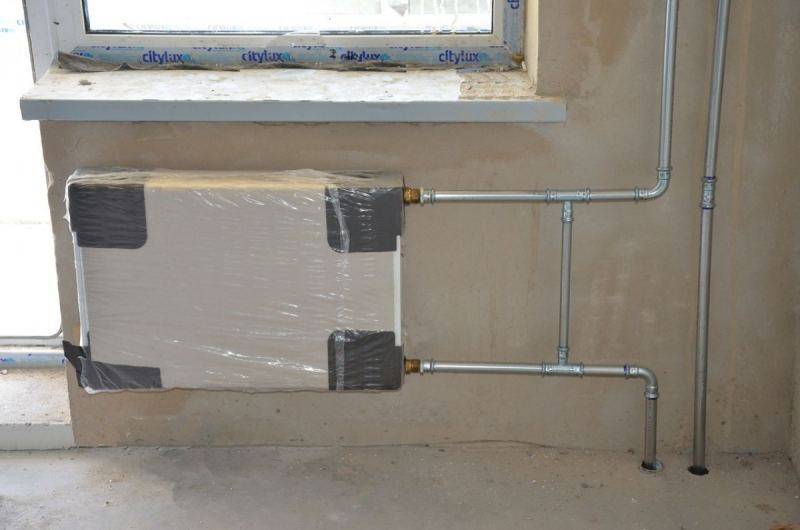

The cold heat carrier displaces the heated one upwards, it moves through the system, giving off heat, and then, having gained density, returns back to the boiler, etc.
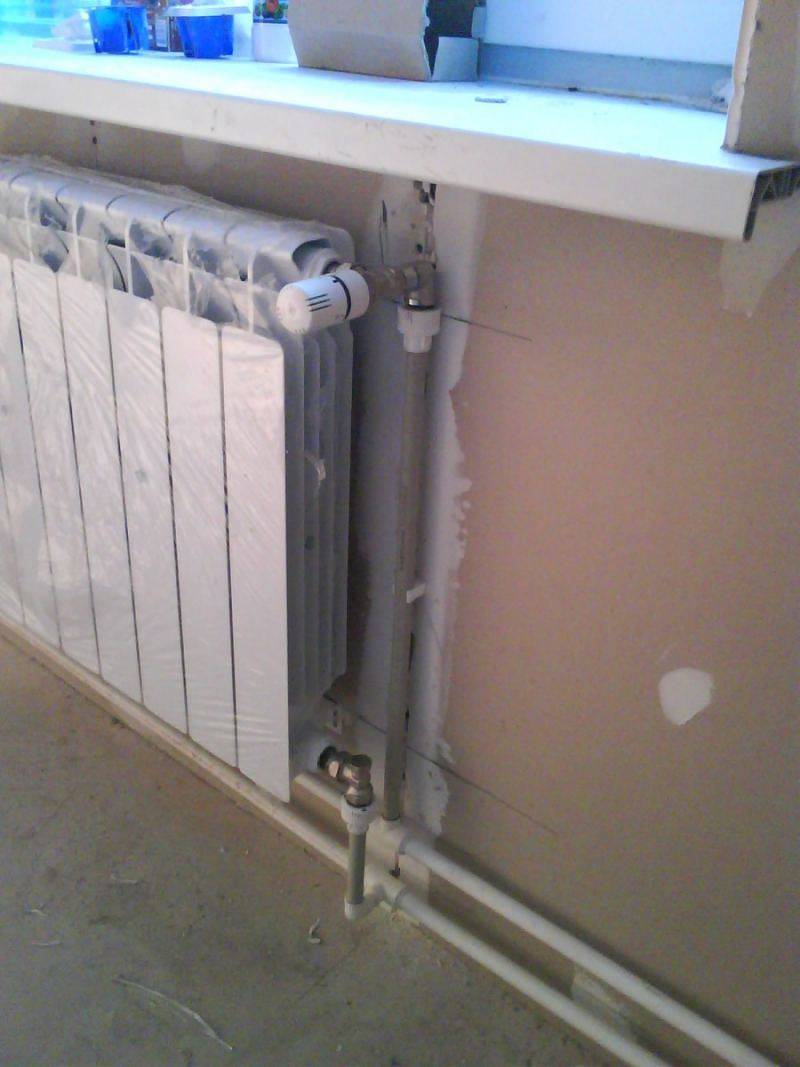

In this way, the circulation of liquid through the system is carried out, accompanied by heating of the room, without a pump and other additional equipment.
An insignificant disadvantage is the small pressure drops in the system, this fact does not allow the system to be mounted on a large radius.
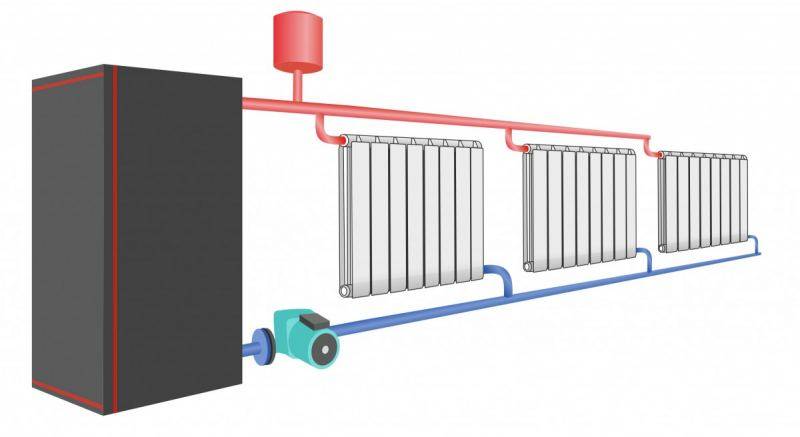

From the moment the boiler is turned on until the moment when the temperature in the room is fixed, a lot of time passes and this is a kind of disadvantage.


Another disadvantage is the condition of inclined installation of pipes, which is simply necessary in order for the liquid to move in the required direction.
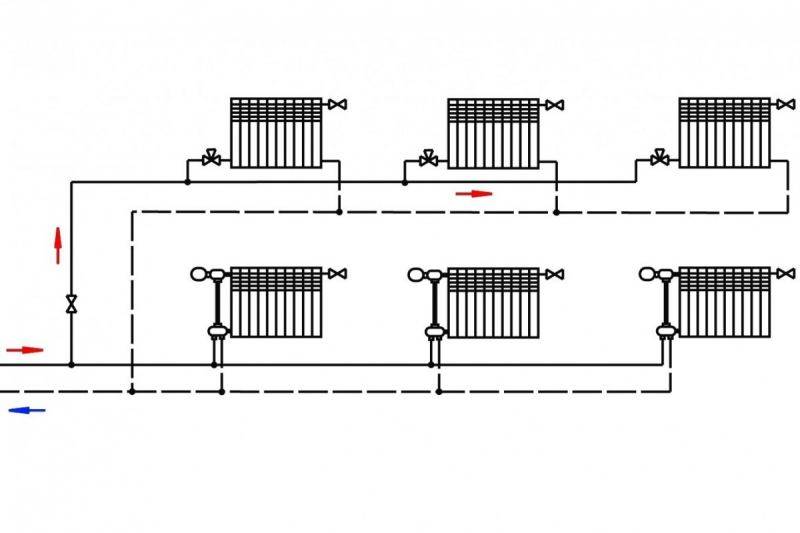

A significant plus lies in the ability of the system to self-regulate - when the ambient temperature decreases, the circulation rate increases.
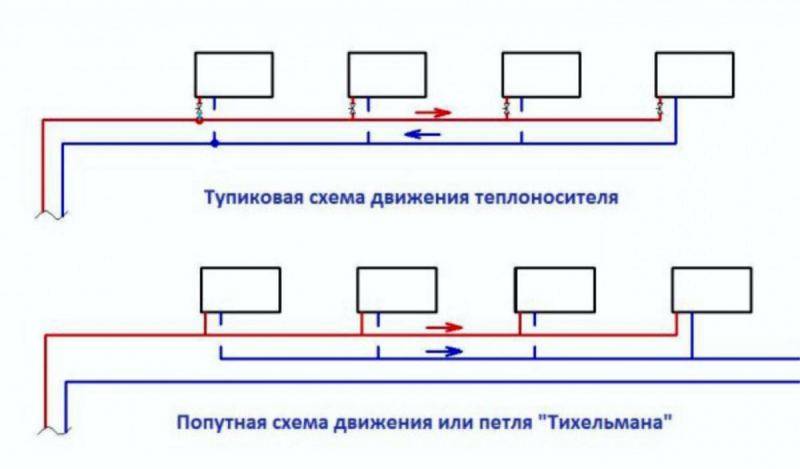

In addition to temperature, the following factors affect the speed of fluid movement: the radius of the pipes, the material from which they are made, their cross-section, the number of turns in the system, the presence of fittings and their type.
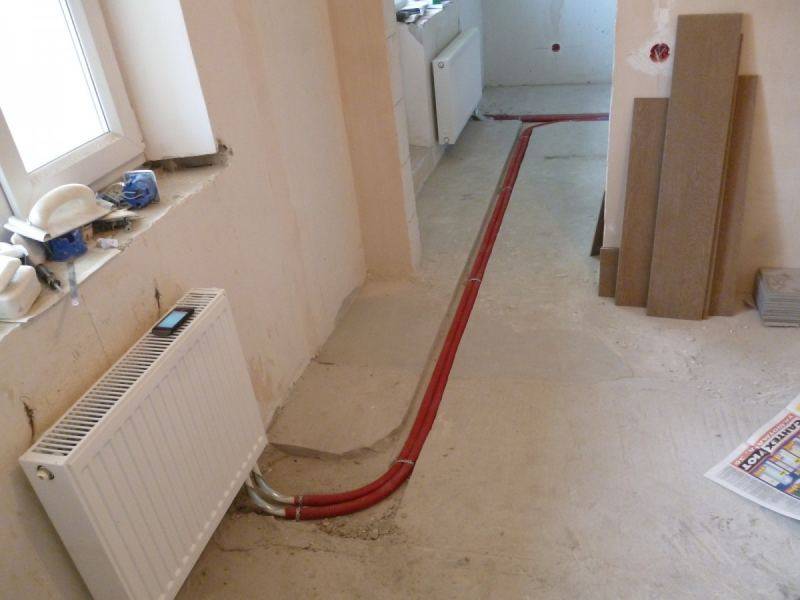

What do the two systems have in common
Any of the above heating systems include the following main components:
- boiler;
- thermostatic valve;
- safety valve;
- radiators;
- membrane expansion tank;
- valve (ball valve);
- circulation pump. This unit controls the forced circulation of the coolant in both one-pipe and two-pipe heating systems.
There are also general aspects of the installation.
Boiler location. This factor is a very important parameter when choosing the most suitable heating scheme for a private house. Acting as the main heating equipment, this unit should be installed below the horizontal center point of the batteries or cooling points. This solution will provide a one or two pipe heating system with natural or forced circulation with the correct gravitational pressure.
Having decided on the location of the boiler, regardless of the type of piping, they usually start marking the points where the remaining elements of the heating system will be installed:
- necessary radiators;
- risers;
- pipes for water supply.
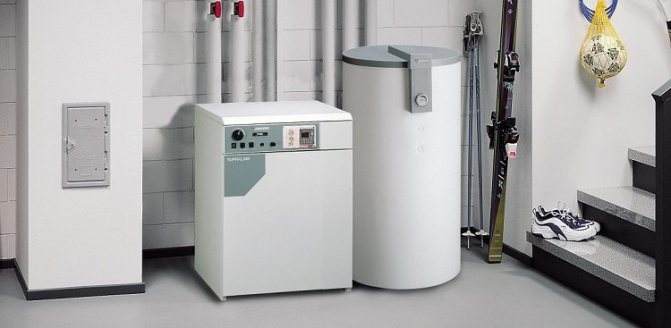

Regardless of the selected heating scheme, the boiler must be located below the level of the batteries, therefore, more often the basement is allocated for the boiler room
Installation of radiators. Installation is carried out directly under the window openings. Regardless of what is chosen - a one-pipe or two-pipe heating system, from the point of view of the laws of physics, this installation of batteries heats not only the room, but also the inner window frame, as well as the glass surface.
Good to know! Among other things, this will eliminate the effect of "crying" windows due to the displacement of the dew point.
For optimal heat transfer, the following conditions must be met:
- the distance between the radiator and the wall should be no more than 5 centimeters;
- the distance from the floor to the lowest point of the battery is 10 centimeters;
- between the window sill and the upper point of the radiator, the correct distance is the same 10 centimeters.
Regardless of which one-pipe or two-pipe heating system is chosen, during installation, one should avoid too many not only bends, but also straight long pipe sections. This applies to any pipes - steel, copper and plastic. The combination of these factors leads to a slow circulation of water, which leads to a decrease in the efficiency of the entire created heating structure.
Compared parameters
The following parameters will determine which heating system is better than one-pipe or two-pipe and in what situations one or another system should be used.
The cost
A one-pipe heating system is more expensive. The high cost consists of two main factors:
The need to increase the number of sections in each radiator next in the direction of coolant circulation. The one-pipe scheme consists of one supply pipeline, through which the coolant passes through the entire heating circuit, sequentially entering each heating device. From each radiator, the coolant comes out several degrees colder than when entering the radiator (part of the heat, about 10 ° C, is given to the room). Therefore, if a coolant with a temperature of 60 ° C enters the first radiator, then a coolant with a temperature of 50 ° C comes out of the radiator, then 2 flows mix in the supply line, as a result of which the coolant enters the second heating device with a temperature of about 55 ° C ... So there will be a loss of about 5 ° C after each radiator. It is to compensate for these losses that it is necessary to increase the number of sections for each subsequent heating device.
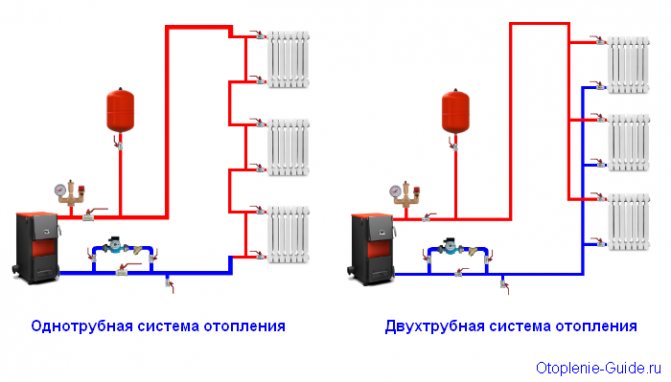

Which heating system is better than one-pipe or two-pipe? What is the difference?
In a two-pipe scheme, there is no need to increase the number of radiator sections, since each device receives a coolant of almost the same temperature. In the two-pipe there is both a supply and a return line, to which each heater is simultaneously connected. Having passed through the radiator, the coolant immediately enters the return line and is directed to the boiler for further heating. Thus, each radiator receives almost the same temperature (heat losses are present, but they are very insignificant).
Note! The best application for a one-pipe system is in small heating systems with no more than 5 radiators. With such a number of heating devices, the coolant, passing sequentially through all 5 radiators, does not lose heat in such critical quantities as in one-pipe systems with a large number of heating devices.
The need to use an enlarged supply pipeline.If the supply pipeline is too "thin", this will lead to the fact that many radiators simply will not get the heated coolant. A large diameter pipe allows you to deliver the heated coolant to as many heating devices as possible. The thicker the supply pipe is, the fewer sections need to be added to each radiator.
Thus, an increase in the number of radiator sections and an increase in the diameter of the supply line makes a one-pipe system more expensive in comparison with a similar two-pipe system.
Profitability
The two-pipe scheme is more economical to operate. As noted above, in order to achieve uniform heating of all radiators in a one-pipe scheme, a "thick" feed is required, as well as an increase in the number of sections in radiators. All this increases the volume of the coolant, and the more coolant in the system, the more fuel is required to heat it. Therefore, to the question of which heating system is better than one-pipe or two-pipe from the point of view of efficiency, the answer will be in favor of a two-pipe system.
Installation process
A single tube is a more complex system in calculations, because it is necessary to correctly calculate how many sections should be increased for each subsequent heater
In addition, special attention must be paid to the calculation of the supply line and the radiator connection.
Which heating system is better: one-pipe or two-pipe?
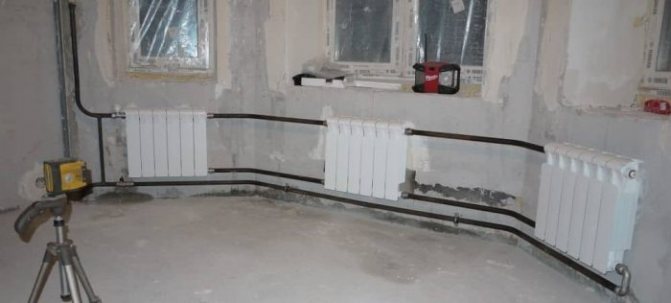

The main criterion for selection is the building, the number of its rooms, their sizes. With one-story houses of a small area, as a rule, the owners are quite capable of providing high-quality heating with one-pipe systems. Heating in this case will be relatively uniform, the work will not take a maximum of time, and the costs of home improvement will not become catastrophic.
Solid buildings with multiple floors and a large number of rooms require more advanced, energy efficient pumping designs. Therefore, savings should not be at the forefront here, because the main thing in the house is comfort. The high costs, no doubt, will soon pay off: the possibility of room-by-room temperature control using thermostats (thermal heads) makes two-pipe systems more economical.
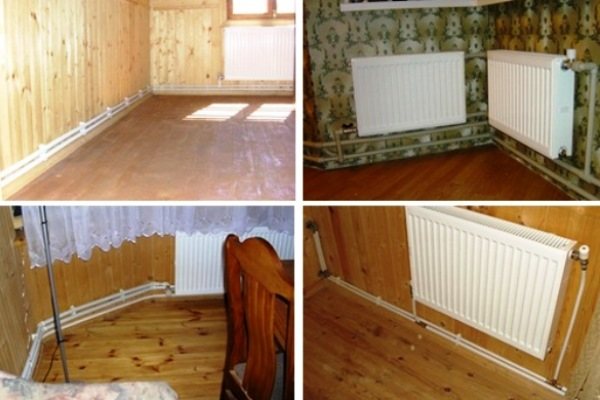

The appearance on the market of inexpensive materials - pipes made of metal-plastic and PVC - can further tip the scales in the direction of two-pipe heating. In addition to reducing the cost of construction, such pipes have another important advantage - simple, quick installation, so the advantage of two-pipe, more modern designs is already becoming obvious.
Which heating system is better: one-pipe or two-pipe? The owners of the building themselves must find the answer. The first scheme is simple, and its installation is relatively quick. The second design is more flexible, customizable, but much more money will be needed to equip it. However, before the final choice, you need to take into account one "but". If you install a heating system that is completely unsuitable for the house, then soon the owners will face a new large-scale operation - re-equipment, and it promises very serious expenses.
What experts think about this can be heard in this video:
Which system to choose
Both types of heating piping have their positive aspects. The final choice of the system is influenced by the area of the heated room, the number of storeys of the building and the size of the budget allocated for the implementation of the project.
For a small cottage, consisting of 1-3 floors, with a small number of rooms, an improved one-pipe structure is perfect. In this case, to improve efficiency and balance temperatures, the wiring begins in the coldest room.
Large buildings, for which more than 10 convectors are needed, are equipped with a two-pipe heating system. The same model is chosen for structures that are difficult to insulate.For example, those with glass walls.

